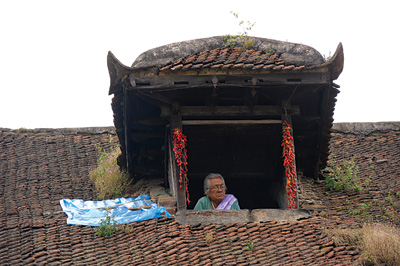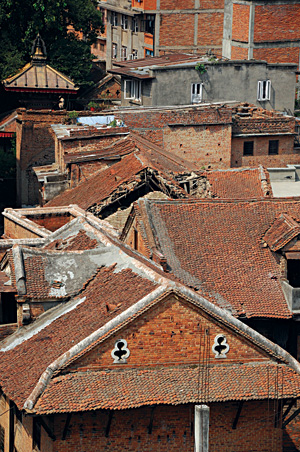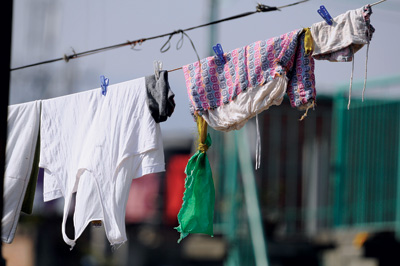The view from Kathmandu’s rooftops is one that grows on you, a part of your every day that you learn to appreciate.
A  favorite photo of mine is of a young Nepali woman wistfully looking into the distance from her perch on a high rock promontory. It was taken years ago when I was visiting the Gurung highland village of Vishnu Maya, the “Nepali Aama” of Broughton Colburn’s beloved book. The young woman and I had struck up a special friendship in the few days I was in her village doing research for my theatre production of Nepali Aama. We giggled away like school girls one night at the sheer incongruity of my big blond presence sleeping next to her and other younger sisters on the mud floor. I treasure the photo as a memento of that special trip, but now living in a third floor flat, I find that I have new images---like mental snapshots--of people gazing into the distances from their close by or far off rooftops.
favorite photo of mine is of a young Nepali woman wistfully looking into the distance from her perch on a high rock promontory. It was taken years ago when I was visiting the Gurung highland village of Vishnu Maya, the “Nepali Aama” of Broughton Colburn’s beloved book. The young woman and I had struck up a special friendship in the few days I was in her village doing research for my theatre production of Nepali Aama. We giggled away like school girls one night at the sheer incongruity of my big blond presence sleeping next to her and other younger sisters on the mud floor. I treasure the photo as a memento of that special trip, but now living in a third floor flat, I find that I have new images---like mental snapshots--of people gazing into the distances from their close by or far off rooftops.
In the peopled world of Kathmandu, filled with sights and sounds, I have become used to family members from the flat below suddenly appearing in our walk-through apartment on their way to the roof and early morning puja. I first thought the extended bell ringing was an alarm clock, but now recognize the sound as part of the ritual welcoming the gods again to our shared abode. The man bringing water also can startle as he seems magically to appear at the kitchen door and friends, too, just walk in. Perhaps in comic recognition of these surprises, my grandson and I have taken to hiding behind doors and jumping out at each other.
 I fuss at the house kids as they run up to the roof and down and try out the banister as a slide. But their shouts are part of the natural cacophony of our daily lives with the guards at the next door NGO coughing and spitting in another morning ritual, the man selling fish ringing his bicycle bell and calling out what sounds like “Marco.” (I tease my husband who hates that loud children’s swimming pool game of shouting out “Polo” from the inside rooms as the shouts of “Marco” continue down the street.) The vegetable vendors too, ring their bicycle bells, calling out “Tarkari!” Saffron robed sadhus wander by adding their shouts and tinkling bells. And there is a special night symphony of barking dogs, late arriving cars, the metal scraping of opening gates, the voices of guards talking around a fire, and wonderful guitar music drifting up from a party across the street.
I fuss at the house kids as they run up to the roof and down and try out the banister as a slide. But their shouts are part of the natural cacophony of our daily lives with the guards at the next door NGO coughing and spitting in another morning ritual, the man selling fish ringing his bicycle bell and calling out what sounds like “Marco.” (I tease my husband who hates that loud children’s swimming pool game of shouting out “Polo” from the inside rooms as the shouts of “Marco” continue down the street.) The vegetable vendors too, ring their bicycle bells, calling out “Tarkari!” Saffron robed sadhus wander by adding their shouts and tinkling bells. And there is a special night symphony of barking dogs, late arriving cars, the metal scraping of opening gates, the voices of guards talking around a fire, and wonderful guitar music drifting up from a party across the street.
After a year of living in the flat, with windows in every room and a kind of 360 degree view, I recognize our immediate neighbors, who appear and disappear in yards and driveways, at windows and rooftops, and mark their family’s life and progress. There is a new baby across the street, and the mother or brother lean or climb out of the window of the small porch of their servant quarters to hang up and retrieve laundry from the railings. This little family creates a peaceful pastoral scene as the father polishes the big black car marked “Press” to a fine shine, while the mother, seated on a bright blanket on the cement, similarly makes her chubby baby glisten as she adoringly gives him an oil massage.
 On a rooftop right off our side-facing living room and master bedroom, we have a dour neighbor who appears and can clearly look inside. Always unsmiling, he gives us a start as we look up from the couch to see him there. We signal that he is nearby and avert our eyes and, after what seems a respectable time, discretely close a few curtains. Directly off our back kitchen porch is another close rooftop and at meals I admire the bright turquoise and red clothes hung there. The other day, I was amused to see a man reading Fr!day with a cup of chiya poised on the roof edge. We are sorry that these neighbors are building another floor on top of the roof. Soon we will have a less clear view and need to look up to see their bright laundry.
On a rooftop right off our side-facing living room and master bedroom, we have a dour neighbor who appears and can clearly look inside. Always unsmiling, he gives us a start as we look up from the couch to see him there. We signal that he is nearby and avert our eyes and, after what seems a respectable time, discretely close a few curtains. Directly off our back kitchen porch is another close rooftop and at meals I admire the bright turquoise and red clothes hung there. The other day, I was amused to see a man reading Fr!day with a cup of chiya poised on the roof edge. We are sorry that these neighbors are building another floor on top of the roof. Soon we will have a less clear view and need to look up to see their bright laundry.
Building is a constant in our neighborhood and we watched the addition of a room on the roof of the big white NGO, although none of the window panels and arches that decorated the lower floor windows was added. Other buildings are going up at a distance and we look at the workers hanging precipitously from scaffolding and windows as they construct walls and paint window ledges. Like so much in Nepal, construction seems impossibly archaic, difficult, and yet human centered. Buildings go up, often in record time, without the fancy cranes and machine sounds of the USA, but gradually views become more hemmed in.
 From the south facing window, we can view high up a woman who seems a kind of water sprite. She often appears bare shouldered with a towel around her taking a bath in the sunny space. At other times, she stamps up and down in a circle like an Italian peasant woman pressing wine with her feet, maybe washing clothes hidden from our view. Regular as clock work is the gardener in the building right below us, who prunes his beautiful flowers and rolls the lawn. A man of the house takes his morning exercise in the small garden, circling round and round the yard and up and down the three floors of stairs like a well groomed hamster in a maze. Initially my husband and I found this funny, but I guess we too have been observed pulling back our kitchen curtains or standing by the window and drinking coffee with disheveled hair. One day the wife, whom I often had observed getting in the car with the husband, waved to me and we now chat in a friendly way as we encounter each other in the street.
From the south facing window, we can view high up a woman who seems a kind of water sprite. She often appears bare shouldered with a towel around her taking a bath in the sunny space. At other times, she stamps up and down in a circle like an Italian peasant woman pressing wine with her feet, maybe washing clothes hidden from our view. Regular as clock work is the gardener in the building right below us, who prunes his beautiful flowers and rolls the lawn. A man of the house takes his morning exercise in the small garden, circling round and round the yard and up and down the three floors of stairs like a well groomed hamster in a maze. Initially my husband and I found this funny, but I guess we too have been observed pulling back our kitchen curtains or standing by the window and drinking coffee with disheveled hair. One day the wife, whom I often had observed getting in the car with the husband, waved to me and we now chat in a friendly way as we encounter each other in the street.
Surely the glory time for rooftops is Dashain when young men and boys flew kites from the top of so many of the nearby apartment buildings. From our street facing windows, the boys would appear precariously balanced on sloped tile or railings of roofs, giving them a few feet advantage as they sent their kites far into the sky. I never saw the kite flyers acknowledge each other as competitors, but they must have been aware of their kites flying close to the others, crossing over strings, and disappearing into the blue.
Initially I was a bit irked by the communal living of Nepal, especially the smells (garlic and onions for Daal Bhatt cooking at 10 am), sounds (the grandfather talking in the stairwell, the TV), and sudden hallway appearances, but now I find it consoling. Perhaps because my husband is in the States for business, I like the sense of people always home, always around me, and our glimpsed and shared lives. It seems wise to use roofs for water storage, solar heating, and clothes drying, and roof parties, flower pots, and prayer flags. I don’t think I will welcome a return to the sterile environment of closed roofs and houses in the USA, with streets filled only with people quietly walking their dogs or passing cars.
The obvious suddenly occurs to me as I sit at my desk and look out to the horizon: there is another kind of rooftop in Nepal--the Himalayan mountains, rooftop of the world. Maybe we notice the bright banners of clothes, kites, and faces on rooftops by the practice of lifting our eyes to catch a glimpse of those snowy peaks, which also can suddenly appear and disappear. And I picture the most beautiful of human constructed rooftops atop the white hemisphere of the Boudhanath Stupa, a golden spire and the ever compassionate eyes of the Buddha looking down at us. ■










